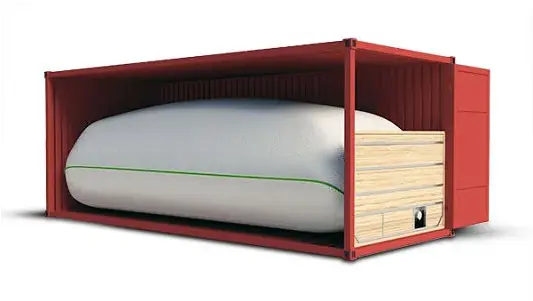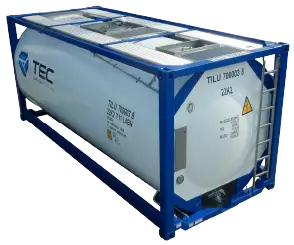Bulk liquid transport is a critical part of many global supply chains, particularly in the chemical, food-grade, and industrial sectors. Selecting the right liquids container for your cargo is more than a logistics decision, it can influence product integrity, cost efficiency, environmental impact, and compliance with international standards.
Two of the most common container options for shipping bulk liquids are ISO tanks and flexitanks. Both are widely used, but they differ significantly in structure, handling, safety, and suitability depending on the cargo type.
In this article, we compare ISO tanks and flexitanks across the metrics that matter most, and explain why ISO tanks are often the preferred choice for operators transporting chemical products and other sensitive liquids.
At TEC Container Solutions, we specialise in ISO tanks designed for safe, efficient, and sustainable liquid transport. Here, we’ll explore the key differences between ISO tanks and flexitanks, helping you make an informed decision for your business.
What Are ISO Tanks?
An ISO tank is a cylindrical, stainless-steel tank container built to strict ISO (International Organization for Standardization) dimensions and safety codes. It’s mounted inside a protective steel frame and designed specifically for transporting bulk liquids, including hazardous and non-hazardous substances.
ISO tanks are reusable, highly durable, and come with robust safety features including pressure relief valves, insulation, and multi-modal handling compatibility (road, rail, sea). They typically carry between 21,000 and 26,000 litres of liquid and can safely handle everything from petrochemicals and acids to food products and pharmaceuticals.
TEC’s ISO tank solutions are engineered to meet T11 tank standards and are suitable for both leasing and direct sale, depending on your operational needs.
What Are Flexitanks?
Flexitanks are large, single-use bladder systems made of multilayer plastic film, designed to fit inside a standard 20-foot dry shipping container. When filled, they can hold between 16,000 and 24,000 litres of non-hazardous liquid.
Their appeal lies in their low upfront cost and compatibility with widely available dry containers. Flexitanks are commonly used for transporting food-grade liquids, such as wine, edible oils, and non-hazardous chemicals, especially for one-way shipments.
However, their convenience comes with important trade-offs, particularly when it comes to reliability, reusability, and suitability for more regulated cargo types.

Key Differences Between ISO Tanks and Flexitanks
To help you determine the right choice for your application, here’s how ISO tanks and flexitanks compare across the most important factors.
Product Type Compatibility
Flexitanks are limited to non-hazardous liquids, mainly in food and agricultural categories. They are not approved for hazardous chemicals.
ISO tanks can carry both hazardous and non-hazardous goods, including aggressive chemicals, oils, solvents, and corrosives. Their stainless-steel structure makes them suitable for a wide range of chemical transport needs.
Safety and Compliance
Flexitanks are more vulnerable to rupture, leakage, or contamination if improperly installed. Some carriers and ports restrict or refuse flexitank shipments due to leak risks.
ISO tanks are built with safety in mind, from pressure relief systems to structural crash protection. They are compliant with ADR, IMDG, and UN standards for global chemical transport.
ISO tanks offer greater safety and are trusted for sensitive cargo under international regulations.
Reusability and Sustainability
Flexitanks are single-use, contributing to waste and disposal costs. The liner must be discarded after each shipment.
ISO tanks are fully reusable for 20+ years with proper maintenance. This reduces environmental impact and long-term cost, especially for repeat or two-way trade routes.
Operational Efficiency
Flexitanks can be installed at the shipper’s site, but require trained personnel. They also limit reverse logistics due to their one-way use.
ISO tanks can be easily cleaned, refilled, and redeployed across global networks. They offer faster turnaround times in established supply chains.
ISO tanks support long-term efficiency for regular bulk liquid operations.
Cost Considerations
Flexitanks typically have a lower initial cost, making them appealing for shippers moving small quantities or testing new markets.
ISO tanks require higher upfront investment or leasing, but provide better cost-per-trip savings when usage is repeated or volumes are high.
Flexitanks may suit short-term, low-risk routes, but ISO tanks are more cost-effective for long-term, high-volume logistics.
When to Choose ISO Tanks Over Flexitanks
If you’re transporting chemicals, hazardous liquids, or temperature-sensitive cargo, ISO tanks are not just the safer option, they’re often the only compliant one. Their reliability, regulatory alignment, and multi-modal compatibility make them the industry standard for serious bulk liquid logistics.
For operators who value:
Long-term cost savings
Global transport flexibility
Stronger environmental credentials
Regulatory assurance
…ISO tanks provide a clear advantage over flexitanks.

To better understand how ISO tanks perform across different industries, explore our guide to standardised ISO tank uses and specifications.
ISO Tanks from TEC: Built for Performance
At TEC Container Solutions, we supply high-performance ISO liquid containers that meet international standards and support demanding logistics requirements, particularly for chemical and industrial customers.
Our ISO tanks are:
T11-compliant and suitable for a wide range of products
Designed for safe, efficient intermodal transport
Available for sale or lease, globally
Supported by expert consultation to help match tank type to cargo
Whether you’re transitioning away from flexitanks or expanding your international bulk liquid network, we can support your move to safer, more sustainable shipping.
Flexitanks have a place in certain one-way, non-hazardous shipment, but for shippers handling chemicals, regulated cargo, or seeking greater operational control, ISO tanks remain the superior choice. Their versatility, safety profile, and reusability make them an essential part of the modern bulk liquid supply chain.
To explore how ISO tanks can support your business, get in touch with our team. We’ll help you identify the right container strategy for your cargo, routes, and compliance requirements.

